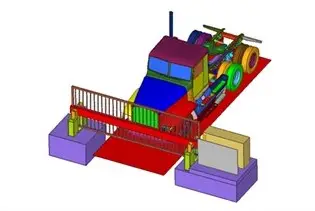FE Analysis of vehicle security barriers

The worldwide rise of terrorism has been accompanied by a series of vehicle-ramming attacks against targets that were characterized by limited protection measures. A tendency has appeared for assaults at unprotected places of people congregation, irrespective of the gathering purpose. The function of vehicle security barriers is to stop the vehicle travelling at speed into a restricted or dangerous area. Full vehicle tests at speed or analyses directly following these tests are used in the design and construction of these barriers.
The successful deployment of vehicle security barrier (VSB) systems, although seemingly simple, often requires a good degree of negotiation and compromise in design., and added to this are the engineering constraints that generally materialize during project feasibility, design and implementation stages. The tests require a vehicle to impact a large number of barriers, with the response of the vehicle being used to assess the performance of the barrier. The primary aim of the analysis is to develop a validated, computational model of road safety barrier, using finite element and smooth particle hydrodynamic methods.
Methodology:
Methods of experimental evaluation for road safety barriers are dictated by the relevant standards documents specific to national and international jurisdictions. These evaluation methods are based upon full-scale testing using vehicles which are indicative of the national vehicle fleet, with a number of evaluation criteria used to assess the capacity of a barrier’s design.
Result interpretation:
A functional barrier system will control both the vehicle’s speed and direction of travel, reducing the kinetic energy of the automobile while providing a re-directive force which will safely alter the course of the vehicle.
